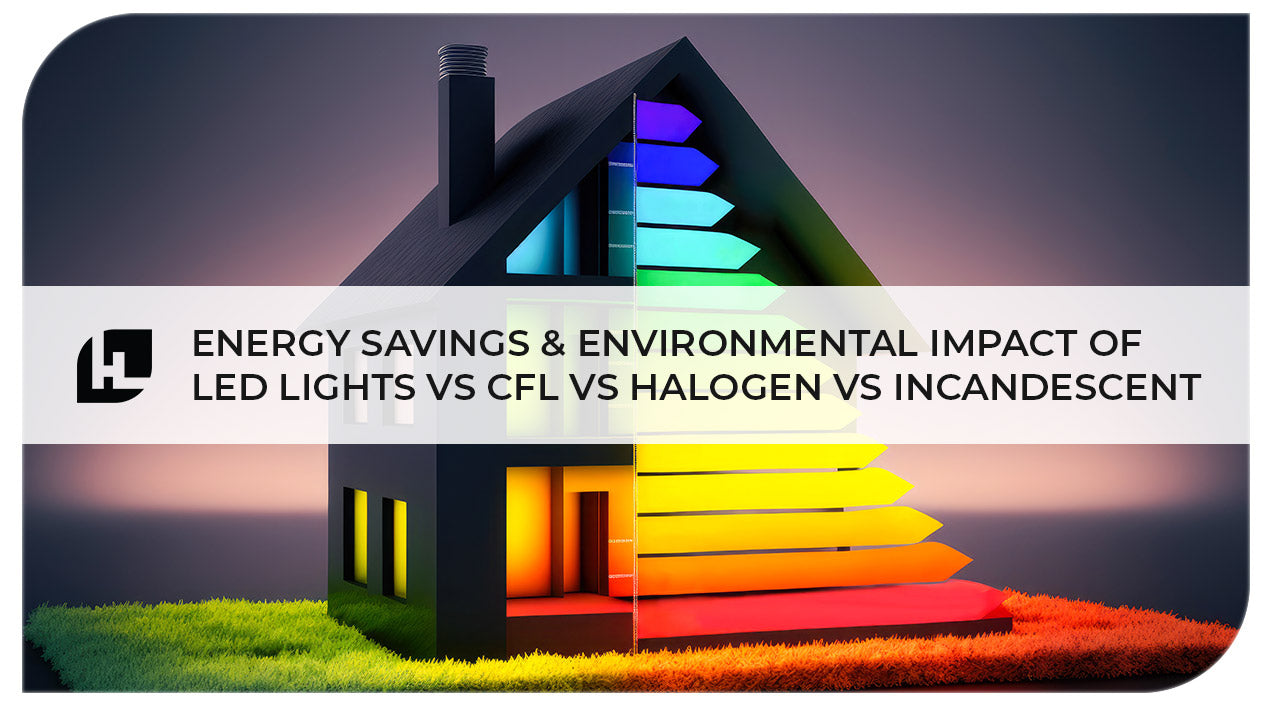Lighting accounts for about 15% of global electricity consumption. As such, choosing energy efficient lighting is one of the easiest ways to reduce energy usage in homes and businesses. The four main types of lighting used are LED, CFL, halogen and incandescent. Each has different characteristics that determine their energy efficiency and environmental impact. This article examines and compares the energy savings and environmental benefits of LED, CFL, halogen and incandescent lighting.
This will also prepare you with the recent changes in the lighting industry where incandescent bulbs that produces 45 lumens per watt and below.

Energy Usage Comparison
LED (Light Emitting Diode) lights are the most energy efficient among the four types. LEDs use only about 20-25% of the energy consumed by an incandescent bulb to produce the same amount of light.
CFL (Compact Fluorescent Lamp) lights use about 70% less energy than incandescent bulbs. They produce the same amount of light while using a fraction of the power.
Halogen lights are more efficient than traditional incandescents, using about 20-30% less energy. However, they are still much less efficient than LEDs and CFLs.
Incandescent bulbs are the least efficient, converting only 10% of electrical input into light. The rest is wasted as heat.
The table below summarizes the differences in power consumption and efficiency:
|
Light Type |
Watts Used |
Lumens Produced |
Efficiency (lumens/watt) |
|
Incandescent |
60W |
800 lm |
13 lm/W |
|
Halogen |
55W |
800 lm |
14.5 lm/W |
|
CFL |
15W |
800 lm |
53.3 lm/W |
|
LED |
16W |
800 lm |
50 lm/W |
As seen above, LED and CFL bulbs produce far more light output per watt compared to incandescent and halogen.
Lifespan Comparison
LED lights have by far the longest lifespan among the four types. The average LED bulb lasts 50,000 hours or more.
CFL lifespan is 6,000-15,000 hours. Halogen bulbs last 2,000-4,000 hours. Incandescent only lasts 750-1,000 hours.
The extremely long life of LEDs means you won't have to replace them for years or even decades. This results in maintenance savings in addition to energy savings.
Cost Comparison
Although LED lights have a higher upfront cost compared to incandescent and halogen bulbs, they save money in the long run. Their energy efficiency and long lifespan lead to savings that offset their higher initial price. At HitLigths we've got you covered. You can get quality LED strips and supplies at Factory Price by simply joining our professional partner program for free.
CFLs are relatively affordable upfront and provide great return on investment through energy savings over their lifetime. However, they are not a good choice when it comes to their environmental impact.
Incandescents and halogens have low upfront cost but end up costing more in the long run due to frequent replacement and high energy use.
Here is the combined table of the lifespan and cost:
|
Light Type |
Lifespan (Hours) |
Upfront Cost |
Lifetime Cost |
|
Incandescent |
1,000 |
Low |
High |
|
Halogen |
3,000 |
Low |
High |
|
CFL |
10,000 |
Medium |
Low |
|
LED |
50,000 |
High |
Low |
As shown, LED and CFL provide the lowest total cost of ownership despite higher initial price.
Environmental Impact
LEDs and CFLs have major environmental benefits compared to old incandescent and halogen bulbs.
Their energy efficiency means they result in lower greenhouse gas emissions from power plants. If everyone switched to efficient lighting, the pollution reduction would be significant.
However, CFLs contain mercury. Incandescents release no mercury but their high energy use still causes more overall environmental harm.
LED and CFL bulbs also last much longer, resulting in less electronic waste from replacements. LEDs in particular almost never need replacing.
Conclusion
In summary, LED lighting provides the maximum benefits across all areas - energy efficiency, cost savings, lifespan and environmental impact. They are the clear winner overall, although they have a higher upfront purchase price.
CFLs are also a great option, offering many benefits at a lower initial cost than LEDs. They outperform halogen and incandescent bulbs across the board.
Halogen lights are a step up from traditional incandescents but still lag far behind LED and CFL technology.
Old-fashioned incandescent bulbs rank last in terms of energy savings, cost and environmental performance. Their use should be minimized whenever possible.
Choose LED or CFL bulbs whenever replacing or installing new lights for maximum energy and cost savings while also helping the environment. The small upfront investment will pay off many times over through lower energy bills and reduced environmental footprint over the lifetime of the bulb.
If you need further assistance, feel free to reach out to us at customerservice@hitlights.com or give us a call at 1 (855) 768-4135. Our team of expert engineers and electricians are here to assist you every step of the way!
If you are a professional installer, an integrator, or a business owner and you want to:
Save MORE! And Do MORE! Project!
You can join our professional partner program RISK-FREE, NO CONTRACTS, NO HASSLE PROCES there is nothing to lose but MORE to GAIN!
*Disclaimer: The information provided in this article is for general informational purposes only.

